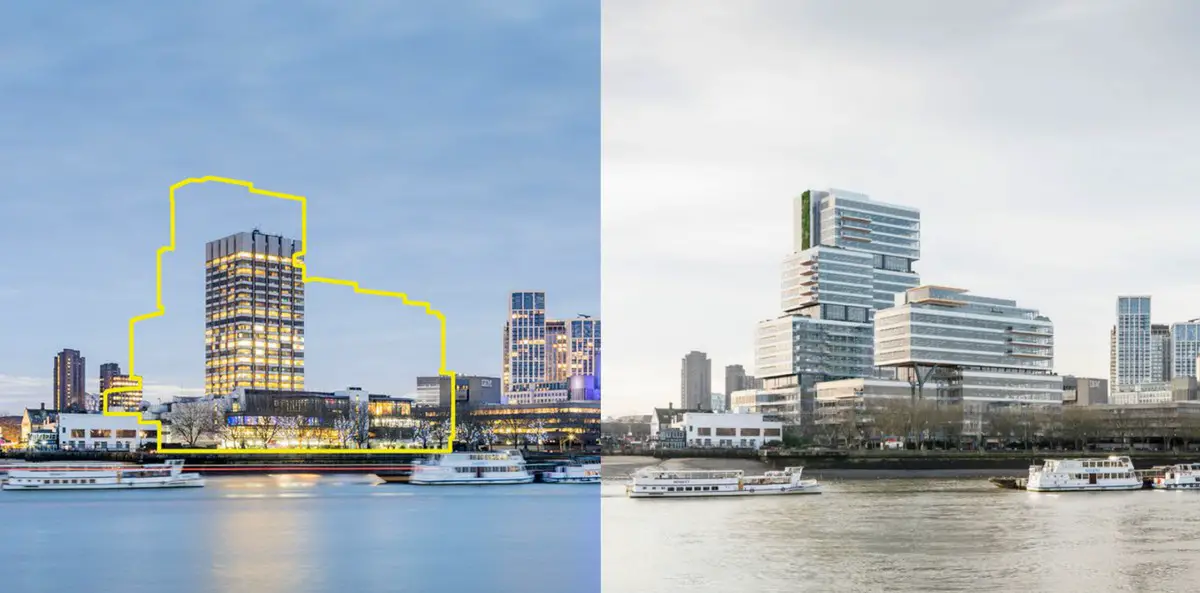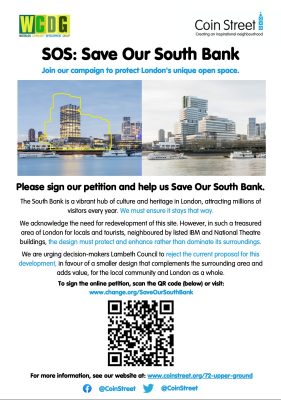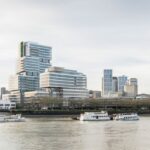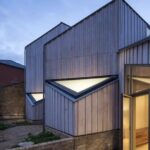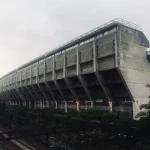ITV London Studios Demolition, Mitsubishi South Bank Proposal, Television Centre Site Redevelopment, Architecture
London Television Centre Site Redevelopment, South Bank
28 February 2022
Social Housing Tenants Outraged by Daylight Robbery
Report by Anstey Horne for Coin Street Community Builders
London Television Centre Site Redevelopment on South Bank
SOS: SAVE OUR SOUTH BANK!
Architects join campaign to protect London’s unique open space
Click on this image to find the gif – before and after:
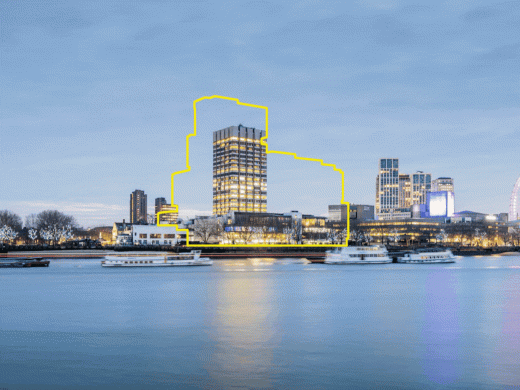
image courtesy of Coin Street Community Builders
London Television Centre Site Redevelopment on South Bank
Coin Street Community Builders (CSCB) and Waterloo Community Development Group (WCDG) are urgently calling for the protection of London’s South Bank. Mitsubishi and its developers CO-RE propose to construct a stack of bulky office blocks more than twice the size of the former tower which will blight the skyline of London’s South Bank.
Renowned architects have joined the campaign and are supporting the launch of a new petition. It calls on the decision makers at Lambeth Council to listen to the hundreds of objections raised to the proposed redevelopment of ITV’s former London Studios.
The new petition urges the decision makers at Lambeth Council to address concerns and rethink what is needed on South Bank. If the decision makers at Lambeth Council are not prepared to listen, then campaigners will ask the GLA, London Mayor Sadiq Khan and Secretary of State, Michael Gove MP to intervene and ‘call-in’ this development.
Liam Hennessy, architect and local resident said: “Denys Lasdun, architect of the adjacent National Theatre and IBM building, wrote about his proposals for the Theatre: “A series of terraces… cascade… gently down to the riverside”. This Mitsubishi proposal is precisely the opposite; it steps up very aggressively at the riverside. Being right on the South Bank Riverside Walk, the huge bulk of the building will severely overshadow this important public promenade. An exceptionally aggressive and unacceptable way to treat London”.
Dr Barnabas Calder, Head of Architectural and Urban History Group, University of Liverpool said: The National Theatre was Lasdun’s career-defining masterpiece and is one of the world’s most admired Brutalist buildings. Its hard-won monumentality is terribly compromised by this proposal. Lasdun fought schemes like this tool and nail, and won the argument”
The National Theatre, Historic England, and the Twentieth Century Society, have also raised their concerns. They have advised Lambeth Council on how this proposed development will impact on the neighbouring National Theatre, IBM and other listed buildings across the Thames such as Somerset House (see notes to editors).
We are asking the public to support our opposition to this planning application by signing the new petition launched today at: https://www.change.org/p/sos-save-our-south-bank
For further details about this campaign please visit https://coinstreet.org/72-upper-ground
Background to these London South Bank buildings
National Theatre Grade 2* and IBM Grade 2 are listed buildings and designed by Sir Denys Lasdun, situated to the west of the site. To the south are Coin Street’s Iroko and Mulberry Housing Co-operatives and to the east are Prince’s Wharf, Gabriel’s Wharf, and Bernie Spain Gardens.
National Theatre states in its advice to decision makers Lambeth Council: “The National Theatre is sited within the cultural quarter of the South Bank, established by a number of important post-war structures, including the Royal Festival Hall, Hayward Gallery and Queen Elizabeth Hall. Together, they form a highly significant ensemble of mid-20th century cultural buildings which are characterised by a strong horizontal emphasis and high-level pedestrian connections. The National also has a strong compositional relationship with the Grade I and II* listed structures of Somerset House and Waterloo Bridge. The National’s siting on the South Bank as the river bends allows a panorama of the City of London that stretches from St Pauls round to Somerset House and onto Westminster Abbey. Its desirability as a location with uninterrupted views up and down the river will be severely impacted. The National considers the impact on the public’s views of the National are also severely impacted by the proposed development”.
Historic England states in its advice to decision makers Lambeth Council: “There would be harm to the Grade II listed IBM building and Grade II listed National Theatre because of the close proximity of the proposed buildings and their impact on the importance of these designated heritage assets in river views. We have identified further harm through the 26-storey tower on the Roupell Street Conservation Area, through an increase in height and massing which compete with and distract from the Georgian domestic architecture in views within the conservation area…We continue to encourage you to explore refinements to the design to minimise the harm identified, including careful consideration being given to a reduction in the height and massing of the proposed buildings”.
The Twentieth Century Society states in its advice to decision makers Lambeth Council: “we consider the currently proposed new building to be an over-development of a site within a sensitive historic environment. Compared to the existing building, the massing of the proposed new building will be further forward on the riverfront side. The new development will impact close views of the listed buildings from the Queen’s Walk and it will also impede wide views, particularly views of the National Theatre from Blackfriars Bridge to the east. The Society’s Casework Committee believes the proposed new building in its current form would harm the setting of the listed buildings on the site and harm the special character and appearance of the riverfront site, which is both a designated conservation area and positive contributor to a strategic view in London. We therefore urge the local authority to refuse planning permission and encourage the applicant to revise the design to substantially reduce the building’s front massing.”
South Bank and Waterloo Neighbours (SoWN) states in its advice to decision makers Lambeth Council: “The mass of the proposed building would be overbearing when experienced from neighbour hurrying streets and public spaces. The proposed building would dominate the local street scene and the conservation area to the detriment. The scale and form of the building would cause harm to important local heritage assets, such as the South Bank Conservation area, IBM building, National Theatre, and the Roupell Street conversation area. The proposed building would result in a significant loss of daylight for several residents. The proposed building would result in a very significant loss of sunlight across important spaces, primarily the Queens walk and Bernie Spain Gardens”.
SoWN is the community body that represents residents, workers, businesses of all sizes and voluntary organisations in the South Bank and Waterloo Neighbourhood Plan formally approved in February 2020. SoWN was responsible for the wide consultation involved in identifying the key issues, for writing the plan and seeing it through to adoption. It represents the local community in monitoring how the plan is implemented, within the wider context of the Lambeth local plan and the London Plan. SoWN objectives are:
Secretary of State, Michael Gove told MPs on 4 November 2021: “We want to have a planning system where people can feel confident that beauty is taken seriously, confident that the environment is benefitting, confident that the money will be there to support infrastructure, and confident that the community has a role ultimately in determining what is right”. He added, “We want to be in a position where communities accept and welcome new development”. [Source: Planning Resource 12 November 2021].
The Former London Television Centre site at 72 Upper Ground was secured by Mitsubishi Estate and CO-RE for £145.6m in November 2019. The application for planning consent was submitted to Lambeth Council in July 2021. The scheme is designed by Make Architects.
Public responses to planning application include 235 objections versus 43 supporting can be accessed at https://planning.lambeth.gov.uk/online-applications/applicationDetails.do?activeTab=neighbourComments&keyVal=QVSLAKBO0FE00&neighbourCommentsPager.page=4
Waterloo Community Development Group (WCDG) was founded in 1972. WCDG is a charity led by Waterloo residents to maintain and develop a healthy and sustainable community, for more land for homes and amenities such as shops and open space, for the benefit of present and future generations.
Coin Street Community Builders (CSCB) is a social enterprise working in Waterloo and North Southwark: https://coinstreet.org/sites/default/files/attachments/Passionate%20about%20our%20neighbourhood.pdf . CSCB owns, manages, and maintains the riverside walkway between the National Theatre and Sea Containers, Bernie Spain Gardens, Oxo Tower Wharf, Gabriel’s Wharf, and Coin Street neighbourhood centre. It is freehold owner of the Iroko, Mulberry, Palm and Redwood housing developments which are leased to primary co-operatives managed by their tenants.
CSCB states in its advice to decision makers Lambeth Council: “The scale, bulk and siting of the proposed development is excessive, overbearing and overly dominant. The impact on daylight received by adjacent Coin Street housing co-operatives will be severe. The riverside walkway and gardens to the north of the proposed development currently enjoy sunshine throughout the lunchtime peak and afternoon but would be cast into shadow by this development. The wanton disregard of the South Bank, one of London’s most popular amenities, is unacceptable and short-sighted!”
Previously on e-architect:
3 December 2021
Building Back Worse – On London’s South Bank!
Design: Make Architects
Location: former London Television Centre site, 72 Upper Ground, South Bank, central London, UK
The government’s Building Back Beautiful agenda is about to be tested
Click on this image to see the gif – showing before and after views:

picture courtesy of Coin Street Community Builders
Building Back Worse – On London’s South Bank!
The government’s Building Back Beautiful agenda is about to be tested by a massive building proposed for one of the UK’s most visited areas.
Proposals by Mitsubishi to demolish ITV’s London Studios and replace them with a mountain of office blocks more than double their size have drawn furious criticism from local community organisations and wider interests.
Historic England, the Twentieth Century Society, and many others have raised concerns about views of St Paul’s Cathedral and impacts on Somerset House, the National Theatre and other listed buildings. Now local organisations are also raising concerns about impacts on daylight, sunlight, and the whole character of the South Bank.
Iain Tuckett, Coin Street Community Builders, says; “The scale, bulk and siting of the proposed development is excessive, overbearing and overly dominant. The impacts on daylight received by adjacent Coin Street housing co-operatives will be severe. The riverside walkway and gardens to the north of the proposed development currently enjoy sunshine throughout the lunchtime peak and afternoon but would be cast into shadow by this development. The wanton disregard of the South Bank, one of London’s most popular amenities, is unacceptable and short-sighted!”
Michael Ball, Waterloo Community Development Group, who led the campaign against the Garden Bridge, said: “The government’s Building Beautiful Commission called for an overt focus on beauty and refusing ugliness as a primary purpose of the planning system. National planning policy puts the creation of beautiful and sustainable buildings and places at the heart of the planning process. These proposals are grotesquery on steroids, a swollen deformity for the South Bank.”
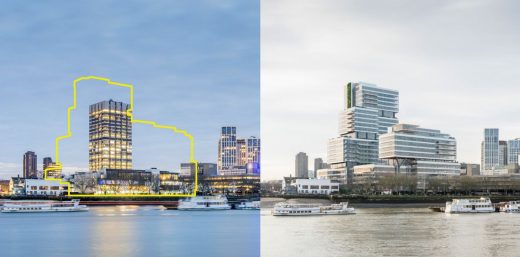
picturee courtesy of Coin Street Community Builders
London Television Centre Site Development
Background:
On 4 November 2021, Secretary of State. Michael Gove told MPs “We want to have a planning system where people can feel confident that beauty is taken seriously, confident that the environment is benefitting, confident that the money will be there to support infrastructure, and confident that the community has a role ultimately in determining what is right”. He added, “We want to be in a position where communities accept and welcome new development”. (Source: Planning Resource 12 November 2021).
The Secretary of State recently upheld the protection of residential daylight and sunlight afforded by the British Research Establishment (BRE) standards in his decision on nearby 8 Albert Embankment, see https://www.gov.uk/government/publications/called-in-decision-8-albert-embankment-london-borough-of-lambeth-ref-3254203-23-june-2021
National Theatre Grade 2* and IBM Grade 2 are listed buildings and designed by Sir Denys Lasdun, situated to the west of the site. To the south are Coin Street’s Iroko and Mulberry Housing Co-operatives and to the east are Prince’s Wharf, Gabriel’s Wharf, and Bernie Spain Gardens. See images below.
Neighbourhood planning (enshrined in the Planning Acts of 2012 and 2017) gives communities direct power to develop a shared vision for their neighbourhood and shape the development and growth of their local area. Neighbourhood planning provides a powerful set of tools for local people to plan for the types of development to meet their community’s needs and where the ambition of the neighbourhood is aligned with the strategic needs and priorities of the wider local area. Source: https://www.legislation.gov.uk/ukpga/2017/20/contents/enacted
South Bank & Waterloo Neighbours (SoWN) was established under the above planning acts. In its advice to Lambeth, SoWN states “the mass of the proposed building would be overbearing when experienced from neighbouring streets and public spaces. The proposed building would dominate the local street scene and the conservation area to their detriment. The scale and form of the building would cause harm to important local heritage assets, such as the South Bank conservation area, IBM Building, National Theatre, and Roupell Street conservation area. The proposed building would result in a significant loss of daylight for a number of local residents. The proposed building would result in a very significant loss of sunlight across important public spaces, primarily the Queen’s Walk and Bernie Spain Gardens”.
SoWN is the community body that represents residents, workers , businesses of all sizes and voluntary organisations in South Bank and Waterloo Neighbourhood Plan, formally approved in February 2020. SoWN was responsible for the wide consultation involved in identifying key issues, for writing the Plan and seeing it through to adoption. It represents the local community in monitoring how the plan is implemented, within the wider context of Lambeth Local Plan and London Local Plan. SoWN’s objectives are:
· to promote high standard of planning and architecture in or affecting the area of benefit
· to educate the public in the geography, history, natural history, culture and architecture of the area of benefit
· to secure the preservation, protection, development and improvement of feature or areas of historic or public interest in the area of benefit
The Twentieth Century Society
“considers the currently proposed new building to be an over-development of a site within a sensitive historic environment. Compared to the existing building, the massing of the proposed new building will be further forward on the riverfront side. The new development will impact close views of the listed buildings from the Queen’s Walk and it will also impede wide views, particularly views of the National Theatre from Blackfriars Bridge to the east.
The Society’s Casework Committee believes the proposed new building in its current form would harm the setting of the listed buildings on the site and harm the special character and appearance of the riverfront site, which is both a designated conservation area and positive contributor to a strategic view in London. We therefore urge the local authority to refuse planning permission and encourage the applicant to revise the design to substantially reduce the building’s front massing.”
Historic England states in its advice to Lambeth:
“There would be harm to the Grade II listed IBM building and Grade II listed National Theatre because of the close proximity of the proposed buildings and their impact on the importance of these designated heritage assets in river views. We have identified further harm through the 26-storey tower on the Roupell Street Conservation Area, through an increase in height and massing which compete with and distract from the Georgian domestic architecture in views within the conservation area…We continue to encourage you to explore refinements to the design to minimise the harm identified, including careful consideration being given to a reduction in the height and massing of the proposed buildings.”
The Planning Application and public responses can be accessed at https://planning.lambeth.gov.uk/online-applications/applicationDetails.do?activeTab=neighbourComments&keyVal=QVSLAKBO0FE00&neighbourCommentsPager.page=4
Impact of shadowing on local homes
Predicted overshadowing of the riverside walkway and Bernie Spain Gardens:

Images extracted from the developer’s 72 Upper Ground planning application: Environmental Statement, July 2021
Impact of mass on views from local homes
Views from Stamford Street (left and middle) and Upper Ground (right) – computer generated images of the proposed development:

extracted from the 72 Upper Ground planning application: Environmental Statement, July 2021
London Television Centre Site Redevelopment, South Bank images / information received 03/021221 from Coin Street Community Builders
Location: London Television Centre site, 72 Upper Ground, South Bank, London, England, UK
London South Bank Buildings
Bernie Spain Gardens Transformation, South Bank
Design: West 8 Urban Design & Landscape Architecture
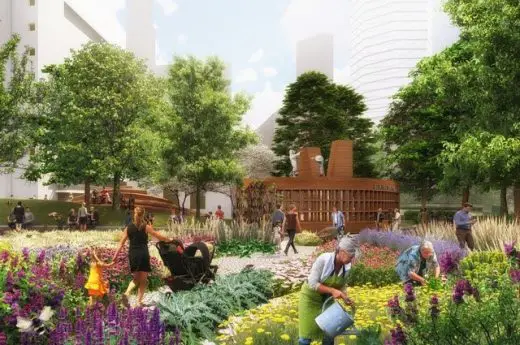
image courtesy of West 8 Urban Design & Landscape Architecture
Bernie Spain Gardens South Bank by West 8
Doon St Tower
Architect: Lifschutz Davidson Sandilands
Doon Street Tower – controversial Southwark skyscraper building design
Oxo Tower Refurbishment
Architects: Lifschutz Davidson Architects (now LDS)
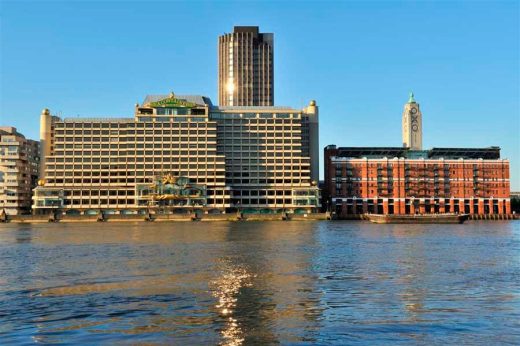
photograph © Nick Weall
Oxo Tower Building
London Building Designs
Contemporary London Architectural Designs
London Architecture Links – chronological list
London Architecture Tours – bespoke UK capital city walks by e-architect
St. Mark’s, 13a North Audley Street, Mayfair
Architects: Donald Insall Associates
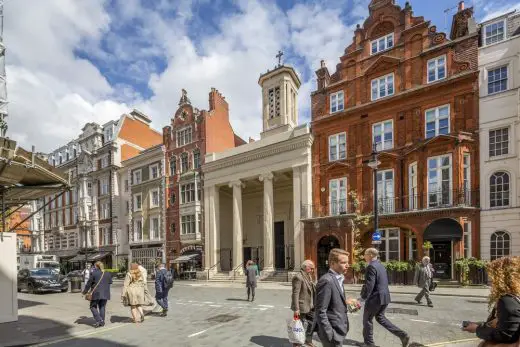
image from architects
One Mayfair Church
The Nest, Wapping
Architects: Gensler
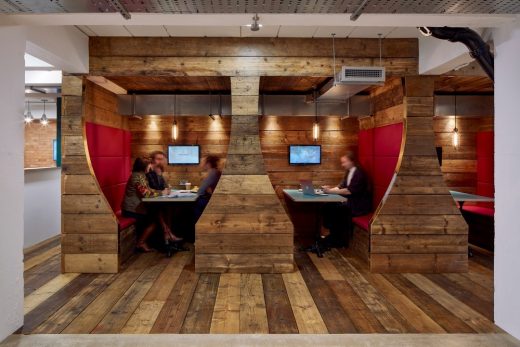
image from architects
The Nest in East London
Jin Bo Law Skybar, Aldgate, East London
Design: Dexter Moren Associates
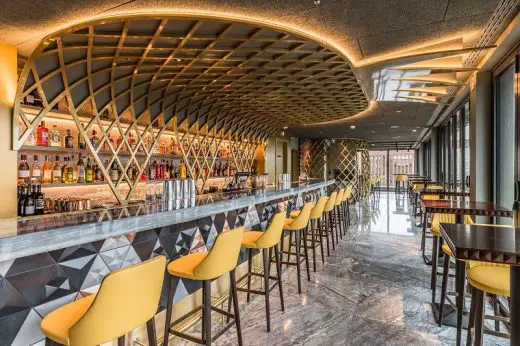
image : Dorsett Hospitality International
Jin Bo Law Skybar in Aldgate
Comments / photos for the London Television Centre Site Redevelopment, South Bank page welcome

